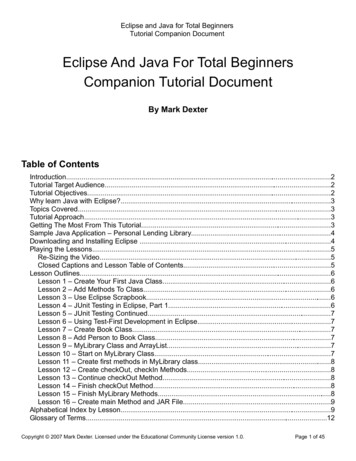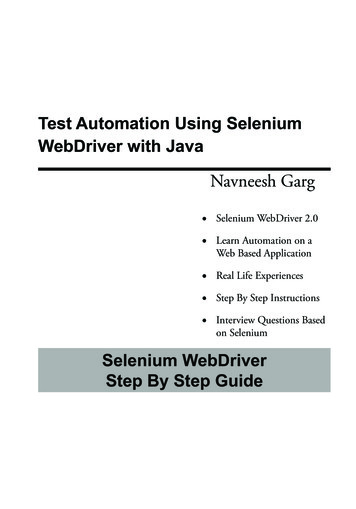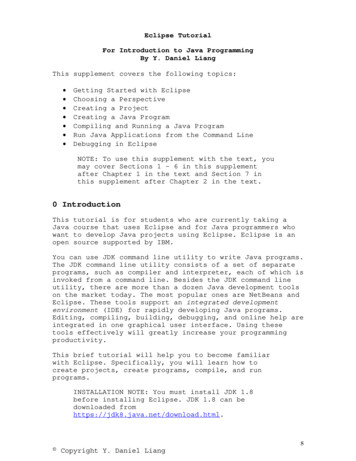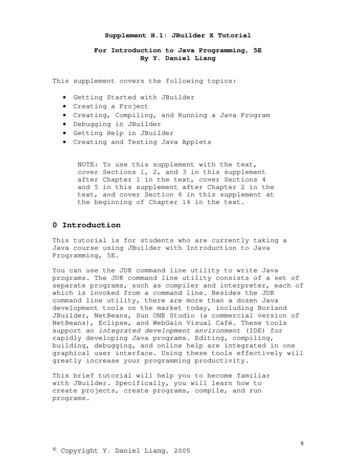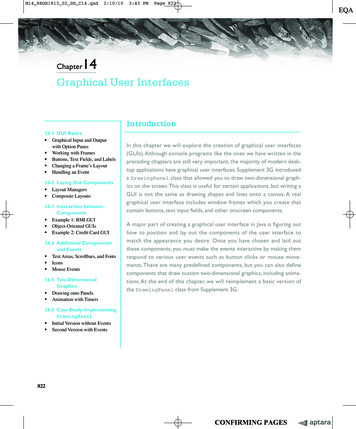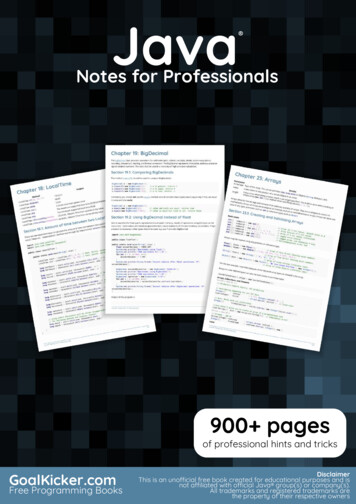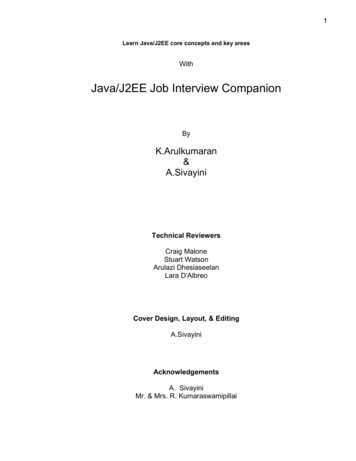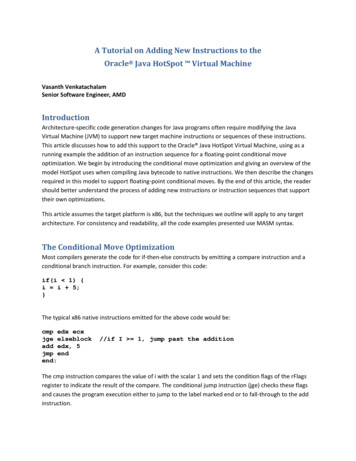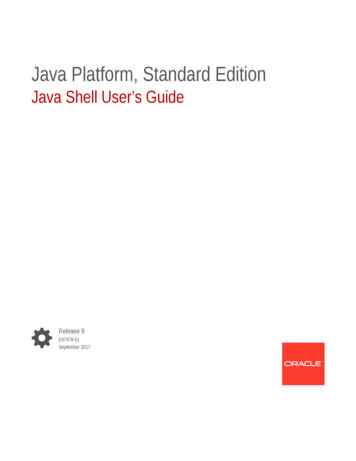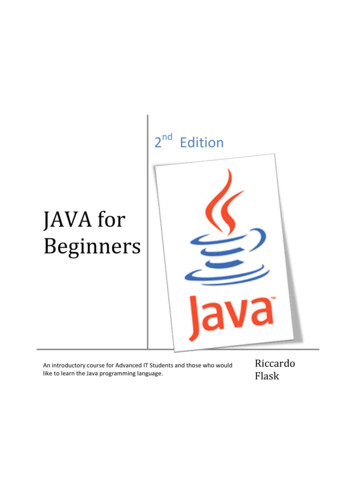
Transcription
2nd EditionJAVA forBeginnersAn introductory course for Advanced IT Students and those who wouldlike to learn the Java programming language.RiccardoFlask
JAVA for BeginnersContentsIntroduction . 5About JAVA . 5OOP – Object Oriented Programming . 5Part 1 - Getting Started . 6The Java Development Kit – JDK . 6My first Java program. 6Using an IDE . 7Variables and Data Types . 8Variables . 8 Test your skills – Example3. 8Mathematical Operators . 9Logical Operators . 9Character Escape Codes . 11Test your skills – Example7. 12Data Types . 13Introducing Control Statements . 16Blocks of Code . 18Test your skills – Example14 . 18The Math Class . 19Scope and Lifetime of Variables . 20Type Casting and Conversions . 21Console Input . 24Using the Keyboard Class . 24Using the Scanner Class . 33Using Swing Components . 34Part 2 - Advanced Java Programming . 35Control Statements - The if Statement . 35Guessing Game (Guess.java) . 36Nested if . 37Guessing Game v.3 . 37if-else-if Ladder . 38Ternary (?) Operator . 39switch Statement (case of) . 41Nested switch . 45Mini-Project – Java Help System (Help.java) . 45Complete Listing . 46Riccardo Flask2 Page
JAVA for BeginnersThe for Loop. 48Multiple Loop Control Variable . 50Terminating a loop via user intervention . 50Interesting For Loop Variations . 51Infinite Loops . 52No ‘Body’ Loops. 52Declaring variables inside the loop . 52Enhanced For loop . 53The While Loop . 54The do-while Loop . 55Mini-Project 2– Java Help System (Help2.java) . 58Complete listing . 59Using Break to Terminate a Loop . 62Terminating a loop with break and use labels to carry on execution . 63Use of Continue (complement of Break) . 66Continue Label. 67Mini-Project 3– Java Help System (Help3.java) . 68Complete Listing . 68Nested Loops . 71Class Fundamentals . 72Definition . 72The Vehicle Class . 72Using the Vehicle class . 73Creating more than one instance . 73Creating Objects . 74Reference Variables and Assignment . 74Methods . 75Returning from a Method . 76Returning a Value . 77Methods which accept Parameters: . 79Project: Creating a Help class from the Help3.java . 83Method helpon( ) . 83Method showmenu( ) . 84Method isvalid( ) . 85Class Help . 85Main Program: . 87Constructors . 88Riccardo Flask3 Page
JAVA for BeginnersConstructor having parameters . 89Overloading Methods and Constructors . 90Method Overloading . 90Automatic Type Conversion for Parameters of overloaded Methods . 92Overloading Constructors . 94Access Specifiers: public and private . 96Arrays and Strings . 101Arrays . 101One-dimensional Arrays . 101Sorting an Array – The Bubble Sort . 103Two-Dimensional Arrays: . 104Different syntax used to declare arrays: . 105Array References:. 106The Length Variable: . 107Using Arrays to create a Queue data structure ** . 110The Enhanced ‘for’ Loop: . 113Strings . 114Using String Methods . 115String Arrays . 117Vector and ArrayList . 122Employee.java . 125ComparableDemo.java . 126File Operations in Java . 134Template to read data from disk . 138Template to write (save) data to disk . 142Introduction to GUI using AWT/Swing . 143Using Swing to create a small Window. 143Inserting Text inside Window . 144Creating a simple application implementing JButton, JTextfield and JLabel . 145Riccardo Flask4 Page
JAVA for BeginnersIntroductionAbout JAVA“Java refers to a number of computer software products and specifications from Sun Microsystems(the Java technology) that together provide a system for developing and deploying cross-platformapplications. Java is used in a wide variety of computing platforms spanning from embedded devicesand mobile phones on the low end to enterprise servers and super computers on the high end. Javais fairly ubiquitous in mobile phones, Web servers and enterprise applications, and somewhat lesscommon in desktop applications, though users may have come across Java applets when browsingthe Web.Writing in the Java programming language is the primary way to produce code that will be deployedas Java bytecode, though there are compilers available for other languages such as JavaScript,Python and Ruby, and a native Java scripting language called Groovy. Java syntax borrows heavilyfrom C and C but it eliminates certain low-level constructs such as pointers and has a very simplememory model where every object is allocated on the heap and all variables of object types arereferences. Memory management is handled through integrated automatic garbage collectionperformed by the Java Virtual Machine (JVM).”1OOP – Object Oriented ProgrammingOOP is a particular style of programming which involves a particular way of designing solutions toparticular problems. Most modern programming languages, including Java, support this paradigm.When speaking about OOP one has to mention: InheritanceModularityPolymorphismEncapsulation (binding code and its data)However at this point it is too early to try to fully understand these concepts.This guide is divided into two major sections, the first section is an introduction to the language andillustrates various examples of code while the second part goes into more detail.1http://en.wikipedia.org/wiki/Java %28Sun%29Riccardo Flask5 Page
JAVA for BeginnersPart 1 - Getting StartedThe Java Development Kit – JDKIn order to get started in Java programming, one needs to get a recent copy of the Java JDK. This canbe obtained for free by downloading it from the Sun Microsystems website, http://java.sun.com/Once you download and install this JDK you are ready to get started. You need a text editor as welland Microsoft’s Notepad (standard with all Windows versions) suits fine.My first Java programOpen your text editor and type the following lines of code:/*My first programVersion 1This is known as a Block Comment.These lines are useful to theprogrammer and are ignored by theCompiler*/public class Example1 {public static void main (String args []) {System.out.println ("My first Java program");}}Save the file as Example1.java2. The name of the program has to be similar to the filename.Programs are called classes. Please note that Java is case-sensitive. You cannot name a file“Example.java” and then in the program you write “public class example”. It is good practice toinsert comments at the start of a program to help you as a programmer understand quickly what theparticular program is all about. This is done by typing “/*” at the start of the comment and “*/”when you finish. The predicted output of this program is:My first Java programIn order to get the above output we have to first compile the program and then execute thecompiled class. The applications required for this job are available as part of the JDK: javac.exe – compiles the programjava.exe – the interpreter used to execute the compiled programIn order to compile and execute the program we need to switch to the command prompt. Onwindows systems this can be done by clicking Start Run cmd2Ideally you should create a folder on the root disk (c:\) and save the file thereRiccardo Flask6 Page
JAVA for BeginnersAt this point one needs some basic DOS commands in order to get to the directory (folder), wherethe java class resides: cd\ (change directory)cd\[folder name] to get to the required folder/directoryWhen you get to the required destination you need to type the following:c:\[folder name]\javac Example1.javaThe above command will compile the java file and prompt the user with any errors. If thecompilation is successful a new file containing the bytecode is generated: Example1.classTo execute the program, we invoke the interpreter by typing:c:\[folder name]\java Example1The result will be displayed in the DOS window.Using an IDESome of you might already be frustrated by this point. However there is still hope as one can forgetabout the command prompt and use an IDE (integrated development environment) to work withJava programming. There are a number of IDE’s present, all of them are fine but perhaps some areeasier to work with than others. It depends on the user’s level of programming and tastes! Thefollowing is a list of some of the IDE’s available: BlueJ – www.bluej.org (freeware)NetBeans – www.netbeans.org (freeware/open-source)JCreator – www.jcreator.com (freeware version available, pro version purchase required)Eclipse – www.eclipse.org (freeware/open-source)IntelliJ IDEA – www.jetbrains.com (trial/purchase required)JBuilder – www.borland.com (trial/purchase required)Beginners might enjoy BlueJ and then move onto other IDE’s like JCreator, NetBeans, etc. Again it’sjust a matter of the user’s tastes and software development area.Riccardo Flask7 Page
JAVA for BeginnersVariables and Data TypesVariablesA variable is a place where the program stores data temporarily. As the name implies the valuestored in such a location can be changed while a program is executing (compare with constant).class Example2 {public static void main(String args[]) {int var1; // this declares a variableint var2; // this declares another variablevar1 1024; // this assigns 1024 to var1System.out.println("var1 contains " var1);var2 var1 / 2;System.out.print("var2 contains var1 / 2: ");System.out.println(var2);}}Predicted Output:var2 contains var1 / 2: 512The above program uses two variables, var1 and var2. var1 is assigned a value directly while var2 isfilled up with the result of dividing var1 by 2, i.e. var2 var1/2. The words int refer to a particulardata type, i.e. integer (whole numbers). Test your skills – Example3As we saw above, we used the ‘/’ to work out the quotient of var1 by 2. Given that ‘ ’ wouldperform addition, ‘-‘ subtraction and ‘*’ multiplication, write out a program which performs all thenamed operations by using two integer values which are hard coded into the program.Hints: You need only two variables of type integerMake one variable larger and divisible by the otherYou can perform the required calculations directly in the print statements, remember toenclose the operation within brackets, e.g. (var1-var2)Riccardo Flask8 Page
JAVA for BeginnersMathematical OperatorsAs we saw in the preceding example there are particular symbols used to represent operators whenperforming calculations:Operator isionModulusExample – given a is 15 and b is 6a b, would return 21a - b, would return 9a * b, would return 90a / b, would return 2a % b, would return 3 (the remainder)class Example4 {public static void main(String args[]) {int iresult, irem;double dresult, drem;iresult 10 / 3;irem 10 % 3;dresult 10.0 / 3.0;drem 10.0 % 3.0;System.out.println("Result and remainder of 10 / 3: " iresult " " irem);System.out.println("Result and remainder of 10.0 / 3.0: " dresult " " drem);}}Predicted Output:Result and Remainder of 10/3: 3 1Result and Remainder of 10.0/3.0: 3.3333333333333335 1The difference in range is due to the data type since ‘double’ is a double precision 64-bit floatingpoint value.Logical OperatorsThese operators are used to evaluate an expression and depending on the operator used, aparticular output is obtained. In this case the operands must be Boolean data types and the result isalso Boolean. The following table shows the available logical operators:Riccardo Flask9 Page
JAVA for BeginnersOperator& && !DescriptionAND gate behaviour (0,0,0,1)OR gate behaviour (0,1,1,1)XOR – exclusive OR (0,1,1,0)Short-circuit ANDShort-circuit ORNotclass Example5 {public static void main(String args[]) {int n, d;n 10;d 2;if(d ! 0 && (n % d) 0)System.out.println(d " is a factor of " n);d 0; // now, set d to zero// Since d is zero, the second operand is not evaluated.if(d ! 0 && (n % d) 0)System.out.println(d " is a factor of " n);/* Now, try same thing without short-circuit operator.This will cause a divide-by-zero error.*/if(d ! 0 & (n % d) 0)System.out.println(d " is a factor of " n);}}Predicted Output:*Note if you try to execute the above program you will get an error (division by zero). To be able toexecute it, first comment the last two statements, compile and then execute.2 is a factor of 10Riccardo Flask10 P a g e
JAVA for BeginnersTrying to understand the above program is a bit difficult, however the program highlights the maindifference in operation between a normal AND (&) and the short-circuit version (&&). In a normalAND operation, both sides of the expression are evaluated, e.g.if(d ! 0 & (n % d) 0) – this returns an error as first d is compared to 0 to check inequality and thenthe operation (n%d) is computed yielding an error! (divide by zero error)The short circuit version is smarter since if the left hand side of the expression is false, this meanthat the output has to be false whatever there is on the right hand side of the expression, therefore:if(d ! 0 && (n % d) 0) – this does not return an error as the (n%d) is not computed since d isequal to 0, and so the operation (d! 0) returns false, causing the output to be false. Same applies forthe short circuit version of the OR.Character Escape CodesThe following codes are used to represents codes or characters which cannot be directly accessiblethrough a New LineTabBackspaceCarriage ReturnBackslashSingle Quotation MarkDouble Quotation MarkOctal - * represents a number or Hex digitHexUnicode, e.g. \u2122 (trademark symbol)class Example6 {public static void main(String args[]) {System.out.println("First line\nSecond intln("D\tE\tF") ;}}Predicted Output:First LineSecond LineABCDEFRiccardo Flask11 P a g e
JAVA for Beginners Test your skills – Example7Make a program which creates a sort of truth table to show the behaviour of all the logical operatorsmentioned. Hints: You need two Boolean type variables which you will initially set both to falseUse character escape codes to tabulate the resultsThe following program can be used as a guide:class LogicTable {public static void main(String args[]) {boolean p, TP");p true; q true;System.out.print(p "\t" q "\t");System.out.print((p&q) "\t" (p q) "\t");System.out.println((p q) "\t" (!p));p true; q false;System.out.print(p "\t" q "\t");System.out.print((p&q) "\t" (p q) "\t");System.out.println((p q) "\t" (!p));p false; q true;System.out.print(p "\t" q "\t");System.out.print((p&q) "\t" (p q) "\t");System.out.println((p q) "\t" (!p));p false; q false;System.out.print(p "\t" q "\t");System.out.print((p&q) "\t" (p q) "\t");System.out.println((p q) "\t" (!p));}}Riccardo Flask12 P a g e
JAVA for BeginnersPredicted truefalsefalsefalsefalsefalsetrueData TypesThe following is a list of Java’s primitive data types:Data TypeintbyteshortlongDescriptionInteger – 32bit ranging from -2,147,483,648 to 2,147,483,6488-bit integer ranging from -128 to 12716-bit integer ranging from -32,768 to 32,76864-bit integer from -9,223,372,036,854,775,808 to ion floating point, 32-bitDouble-precision floating point, 64-bitcharCharacter , 16-bit unsigned ranging from 0 to 65,536 (Unicode)booleanCan be true or false onlyThe ‘String’ type has not been left out by mistake. It is not a primitive data type, but strings (asequence of characters) in Java are treated as Objects.class Example8 {public static void main(String args[]) {int var; // this declares an int variabledouble x; // this declares a floating-point variablevar 10; // assign var the value 10x 10.0; // assign x the value 10.0System.out.println("Original value of var: " var);System.out.println("Original value of x: " x);System.out.println(); // print a blank lineRiccardo Flask13 P a g e
JAVA for Beginners// now, divide both by 4var var / 4;x x / 4;System.out.println("var after division: " var);System.out.println("x after division: " x);}}Predicted output:Original value of var: 10Original value of x: 10.0var after division: 2x after division: 2.5One here has to note the difference in precision of the different data types. The following exampleuses the character data type. Characters in Java are encoded using Unicode giving a 16-bit range, ora total of 65,537 different codes.class Example9 {public static void main(String args[]) {char ch;ch 'X';System.out.println("ch contains " ch);ch ; // increment chSystem.out.println("ch is now " ch);ch 90; // give ch the value ZSystem.out.println("ch is now " ch);}}Riccardo Flask14 P a g e
JAVA for BeginnersPredicted Output:ch is now Xch is now Ych is now ZThe character ‘X’ is encoded as the number 88, hence when we increment ‘ch’, we get characternumber 89, or ‘Y’.The Boolean data type can b
java.exe – the interpreter used to execute the compiled program In order to compile and execute the program we need to switch to the command prompt. On windows systems this can be done by clicking Start Run cmd 2 Ideally you should create a File Size: 1MB
